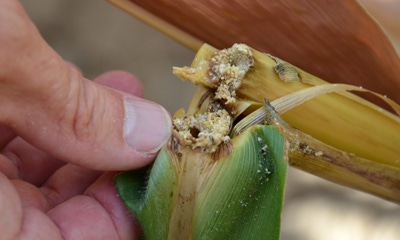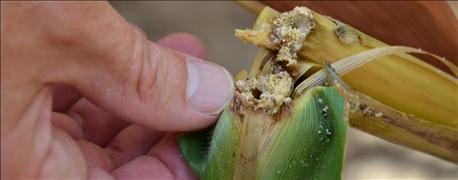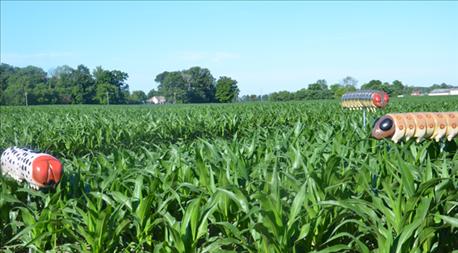
One summer evening many years ago, a group of farm boys began imagining what the future would be like. Pretty soon they were talking about corn ears so big that three or four would fill a gravity wagon, and soybeans so large only a handful would fill a grain truck. Believe it or not, they were stone-cold sober!
This hasn’t happened yet, and it likely never will. Instead, corn ears may get smaller — there will just be more of them. Needless to say, these huge, fake insects brought back memories of that laughter-filled discussion about what technology might bring in the future. It wouldn’t have been so funny if the conversation had turned to giant insects like these.

EXTENSIVE DAMAGE: Corn borers are well-named — they bore into ear shanks and stalks. Note the damage created by corn borers in this non-GMO corn.
Dow AgroSciences used these insects to attract attention at a field day. The subject was PowerCore, a Bt trait now labeled that will be available in Dow AgroSciences seed brands in select hybrids for 2017. The trait is actually not new, spokespersons say. It’s been used outside the U.S., and is just now available here.
Here are three more insects PowerCore controls. In a previous story, you learned about black cutworm, corn earworm and western bean cutworm, also controlled by this trait.
1. fall armyworm (top right in photo)
PowerCore will be the only major Bt trait for aboveground pests that controls this insect using three different modes of action. Some competitors have traits with two modes of action; some control this pest with one. In theory, the more modes of action that control an insect, the longer it should take before resistance develops to the trait.

HUGE DUDES! The real counterparts to these fake pests are much smaller, thankfully. These represent fall armyworm (top right), European corn borer (center right) and southwestern corn borer (bottom left).
The Purdue University Corn and Soybean Field Guide describes fall armyworm as being a smooth-skinned caterpillar that varies in color from light tan or green to nearly black. They can cause feeding damage all the way to harvest.
2. European corn borer (center right in photo)
PowerCore has three modes of action against this insect. The most popular competitors have two modes of action.
European corn borer larvae are beige with tan to black heads, according to the Purdue guide. Look for two brown spots atop each segment of the insect’s body. The second generation, possibly at work now, is difficult to control by spraying because larvae quickly burrow into ear shanks or stalks. Corn borer is a bigger problem in some years than others, experts say. It’s a major concern today primarily in non-GMO corn.
3. southwestern corn borer (bottom left in photo)
Like with European corn borer, the new PowerCore trait has three modes of action to control this insect. Competitive traits already in the field typically have two modes of action against it.
The Purdue guide recommends looking for whitish gray larvae with brown heads and obvious dark-brown to black spots running the length of the body. Mature southwestern corn borer larvae become pale yellow with faint spots and overwinter belowground. The second generation could be active now. As with European corn borer, the second generation of southwestern corn borer is hard to control with foliar insecticides.
About the Author(s)
You May Also Like




